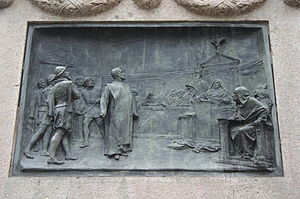On February 17, 1600, Giordano Bruno, a mathematician and Dominican friar, was stripped naked and driven through the streets of Rome. Then he was tied to a stake in the Campo de’ Fiori and burned to death. The records of Bruno’s long prosecution by the Inquisition have been lost, but one of his major heresies was cosmological. He advocated that other stars were like our sun, and that they could each support planets teeming with life. Orthodox thought of the time preferred to think that Earth and humanity were unique.
These days, cosmologists like me may be safer, but our ideas have grown only more radical. One of the most controversial but widely discussed concepts in the field resembles a hugely amplified version of Bruno’s cosmology: the idea that the thing we call “the universe” is just one of an infinite number of regions in a much larger universe of universes, or multiverse. A big focus of my own research asks whether a multiverse can help explain the arrow of time.
Also like Bruno, cosmologists are reaching far beyond what observational evidence can tell them. At the time of Bruno’s death, Galileo had not yet turned the very first telescope upward to the stars. Today, nobody has looked beyond the boundaries of the known universe. In fact, such a far-reaching vision seems impossible by definition.
| Giordano Bruno facing the Inquisition. Relief by Ettore Ferrari's (1845-1929), for the base of the monument to Giordano Bruno (1889), in Campo dei Fiori square in Rome, Italy. Picture by Giovanni Dall'Orto, April 4 2008. (Photo credit: Wikipedia) |
The extent of what astronomers can see is frustratingly limited by the speed of light: one light-year (about six trillion miles) per year. When we look far away, we are looking into the past, and that past doesn’t stretch forever.
Everything we see emerged 13.7 billion years ago from the hot, dense state known as the Big Bang, so we cannot observe anything more than 13.7 billion light-years away. If there is something so far away that its light couldn’t have traveled from there to here in the time since the Big Bang, we cannot observe it.
Obviously, we don’t know what the unobservable part of the universe looks like. It is conceivable that the universe as a whole is finite, closed in on itself like a sphere. It is also possible that it extends infinitely far in space but remains more or less the same no matter how far you go. And finally, it’s possible that the universe extends infinitely far, but conditions vary wildly from place to place. That would be a multiverse
From:
http://discovermagazine.com/2011/oct/18-out-there-welcome-to-the-multiverse#.UM5b86HmCrU
http://www.infidels.org/library/historical/john_kessler/giordano_bruno.html
http://en.wikipedia.org/wiki/Giordano_Bruno



0 comments:
Post a Comment